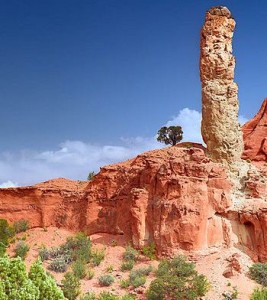The name says it all, especially if you are familiar with the older slide film called Kodachrome. There is so much beautiful scenery there just waiting for the camera! However, to me it may be one of the most significant sites that we took our caravan of 40 to on the Jackson Hole Bible college geology field trip of the Southwest.
Why is this significant? Here we find columns or pipes of light-colored sandstone protruding through a very red-colored Entrada sandstone layer. The light-colored sandstone was pushed up through the upper layer from a layer below like toothpaste. You can see the markings on the “toothpaste” pipe from its intrusion from below. Some of the pipes can be seen in the red sandstone. Others are now standing upright with all of the red sandstone having eroded away leaving the harder and denser lighter-colored sandstone behind.
So what’s the problem? According to standard geology, the pipes of light-colored sandstone come from a layer of sandstone which is supposedly 25 million or more years older than the upper red Entrada sandstone. In 25 million years, the lighter sandstone should have turned into solid rock. In fact, this would have occurred in just a few hundred years. The fact that it squeezed up through the Entrada, tells us that it was not solid, but fluid at the time. That means that those millions of years never existed.
These features certainly fit with the rapid deposition of layers of sediments during the Noahic Flood, but don’t fit the standard models of geology.
Dave Nutting
If you would like to see if an AOI seminar is right for you, or you would like to help the work of Alpha Omega Institute, please visit our website events page or our donate page. Keep up to date with what AOI is doing. Thanks for your partnership.



